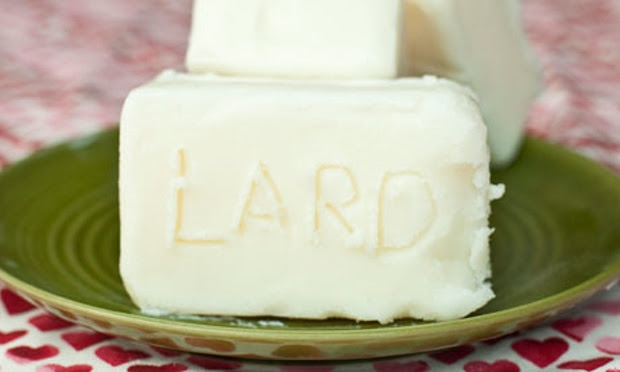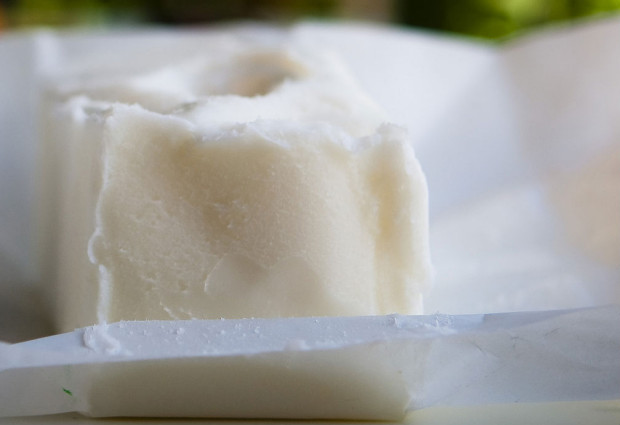Consider lard
Thanks for getting this far. A headline like “Consider lard” will cause many readers to click away in horror, feeling arteries fur, strokes striking, the tempting of fat and fate at the sight of this four letter word. Lard ranks among the most reviled foods in the western world. As Roy Hattersley came to know its very name is a playground metonym for fat. Once, it was the great cooking fat of Europe, from Shetland to Gibraltar and east beyond the Caucasus, in China, Mexico, in South America.
In Ukraine they have a festival devoted to it. Polish immigrants caused a UK shortage in 2004. If your ancestors came from these islands they likely opened their lard-ers and ate bread, lard and salt for countless breakfasts. And not many of them died of obesity. For thousands of years there has been lard wherever there were pigs, and there were pigs, broadly speaking, wherever there weren’t Muslims.
It’s a supremely versatile fat. Because it smokes so little when it’s hot it’s perfect for bringing a golden shatter to a chip or a fritter – only dripping, lard’s bovine equivalent, does a better job. (A specific kind of lard is also called dripping, but let’s not muddle things.) Its large crystals of fat make lard unsurpassable in baking: a pastry crust made with lard – or half-lard, half-butter, as Delia recommends – offers a stunning flaky shortness, that gently encompassing roundedness that wine buffs horribly call mouthfeel.
Before the second world war Britons ate lard without guilt or fear. Its disappearance from our kitchens parallels a surge in the national waistline and an upswing in the cosseted maladies of fat. It’s worth remembering that the very people who so trumpeted the benefits of factory margarine – which we now know caused considerably more harm than good – were the same who lambasted lard and denied its natural glories.
By any estimation, lard is a healthier fat than butter. Gram for gram, it contains 20% less saturated fat, and it’s higher in the monounsaturated fats which seem to lower LDL cholesterol (the “bad” kind) and raise HDL (the “good”). It’s one of nature’s best sources of vitamin D. Unlike shortening it contains no trans fats, probably the most dangerous fats of all. Of course it has more saturated fat than olive oil, but in her splendid book Fat: An Appreciation of a Misunderstood Ingredient, Jennifer McLagan points out that even its saturated fat is believed to have a neutral effect on blood cholesterol. And would you want a pie crust made with extra virgin?
Leaf lard, the highest-quality, surrounds a pig’s loin and kidneys. (Roast pork loin, incidentally, gives the best crackling.) Next in value are the fat on the animal’s back, appropriately called fatback, and the the soft fat from around the internal organs, which has a more pronounced porky flavour. There are two main methods to make or “render” lard: wet and dry. In wet rendering you boil the fat in water. To dry render you simply melt it in a dry pan and skim off any crunchy bits of meat and skin. (Salted, these become the world’s best scratchings.) Wet-rendered lard has a clean, neutral flavour and a high smoke point, while dry-rendered is a nut-brown colour, smokes at a lower heat and tastes faintly of well-roasted pork. The industrial lard of the supermarkets may well have been bleached, deodorised, emulsified and otherwise fiddled with, but homemade or small-scale lard is likely to be be excellent. A kindly butcher might well give you a load of hard pig fat for free to take home and render (unto) yourself.
The best thing about lardy cake is its counterintuitive lightness – the fat brings the dough a refreshing, silky fluffiness. The cake originates in Wiltshire, which was always Britain’s best pig county. In central Europe they cut fatback into cubes and salt it for stews. The Italians cure lardo with rosemary and spices in the coffin-shaped basins of the Carrara marble mines. This lardo di Colonnata is a sublime antipasto, wrapped round prunes or figs, melted over grilled bread, or served with salt and honey. A melting smear of cured, flavoured lard is a wonder over a steak, and a lot of Mexican cuisine (don’t laugh) is unthinkable without lard.
Assaulted by food company propaganda and disillusioned by decades of conflicting advice, many people are returning to diets unsullied by fads and dogma. That lard is both “healthier” than butter and yet so despised shows the empty logic of the standard position. The fat amply qualifies as “real food”, that definition popularised by Michael Pollan as “the sort of food our great grandmothers would recognise as food”. Indeed, its history and heritage make it seem more valuable than ever when you consider what the lard hath given.
https://youtu.be/KddkyZ1UG5g
Read the original post: http://www.theguardian.com/lifeandstyle/wordofmouth/2011/feb/15/consider-lard


